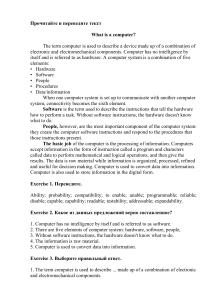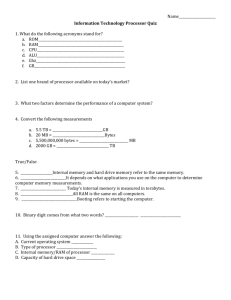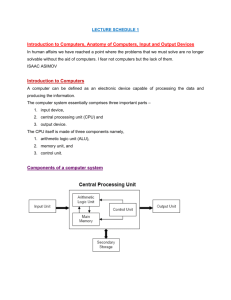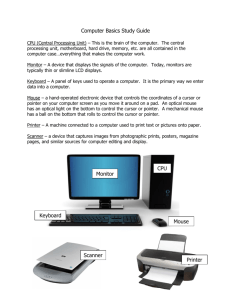Document
advertisement
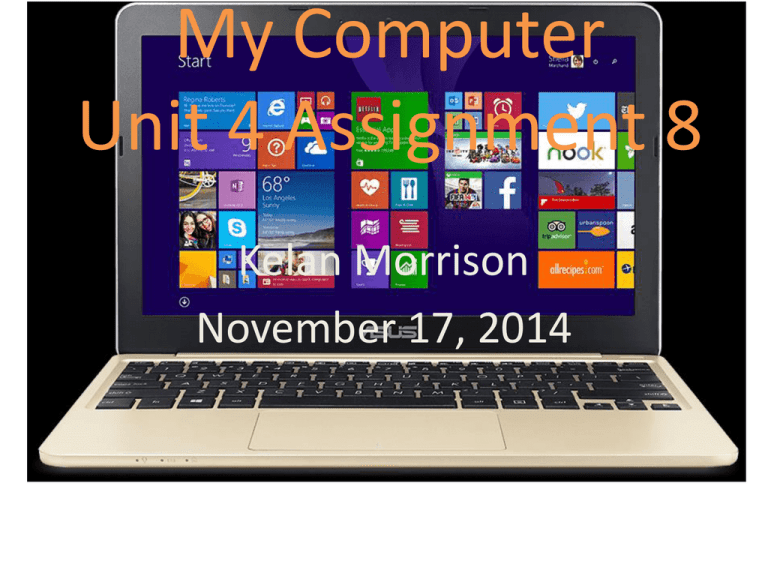
My Computer Unit 4 Assignment 8 Kelan Morrison November 17, 2014 CPU (pronounced as separate letters) is the abbreviation for central processing unit. Sometimes referred to simply as the central processor, but more commonly called processor, the CPU is the brains of the computer where most calculations take place. Random-access memory is a form of computer data storage. A random-access memory device allows data items to be read and written in roughly the same amount of time regardless of the order in which data items are accessed. Read-only memory (ROM) is a class of storage medium used in computers and other electronic devices. Data stored in ROM can only be modified slowly, with difficulty, or not at all, so it is mainly used to distribute firmware (software that is very closely tied to specific hardware, and unlikely to need frequent updates). Monitor=The display device in modern monitors is typically a thin film transistor liquid crystal display Video Card=a printed circuit board controlling output to a display screen. Hard Drive=a high-capacity, self-contained storage device containing a read-write mechanism plus one or more hard disks, inside a sealed unit. CD Rom=a compact disc used as a read-only optical memory device for a computer system. CD-RW=a blank compact disc that can be recorded, erased, and rerecorded many times. Modem=a combined device for modulation and demodulation, for example, between the digital data of a computer and the analog signal of a telephone line. Mouse=A computer mouse is an input device that is most often used with a personal computer. Moving a mouse along a flat surface can move the on-screen cursor to different items on the screen. Speakers=A device that converts analog audio signals into the equivalent air vibrations in order to make audible sound. Although CRT usage has faded, speakers designed for computers are shielded to avoid magnetic interference with the CRT's magnetic coil. Printer=a machine for printing text or pictures onto paper, especially one linked to a computer. Keyboard=a panel of keys that operate a computer or typewriter. OS=An operating system (OS) is software that manages computer hardware and software resources and provides common services for computer programs. Internet Access=Internet access connects individual computer terminals, computers, mobile devices, and computer networks to the Internet, enabling users to access Internet services, such as email and the World Wide Web. Scanner=A scanner is an input device that scans documents and images, which can be imported into a computer. They are available in flatbed or sheet-fed versions and are usually connected via a high-speed USB port. OCR software can be used to recognize text documents imported from a scanner. Digital Camera=a camera that records and stores digital images. Web Cam=a video camera that inputs to a computer connected to the Internet, so that its images can be viewed by Internet users. P4=Pentium 4 is a line of single-core desktop, laptop and entry level server central processing units (CPUs) introduced by Intel on November 20, 2000 and shipped through August 8, 2008. GHZ=A two-gigahertz clock (2 GHz) means at least two billion times. The "at least" is because multiple operations often occur in one clock cycle. Both megahertz (MHz) and gigahertz (GHz) are used to measure CPU speed. MB=a unit of information equal to 220 bytes or, loosely, one million bytes. GB= unit of information equal to one billion (109) or, strictly, 230 bytes. RPM=RPM measures the rotational speed of the motor's spindle. Floppy disks rotate at 300 RPM, while hard disks rotate from 3,000 to 15,000 RPM. CD and DVD platters typically rotate in the range of 2,000-5,000 RPM. Byte=a group of binary digits or bits (usually eight) operated on as a unit. CPU (pronounced as separate letters) is the abbreviation for central processing unit. Sometimes referred to simply as the central processor, but more commonly called processor, the CPU is the brains of the computer where most calculations take place. Intel Atom Z3735 quad-core Bay Trail processor Random-access memory is a form of computer data storage. A random-access memory device allows data items to be read and written in roughly the same amount of time regardless of the order in which data items are accessed RAM: 2GB 32GB of flash storage micro SDXC card slot, 802.11n WiFi, Bluetooth 4.0, 2 USB 2.0 ports, a micro HDMI port, a headset jack Screen Size: 11.6“ 1366 x 768 pixel glossy display OS=An operating system (OS) is software that manages computer hardware and software resources and provides common services for computer programs. Windows 8.1 Mouse=A computer mouse is an input device that is most often used with a personal computer. Moving a mouse along a flat surface can move the on-screen cursor to different items on the screen. Touch Pad Keyboard=a panel of keys that operate a computer or typewriter. Printer=a machine for printing text or pictures onto paper, especially one linked to a computer. hp envy 4500 Microsoft office Dre Beats Studio

